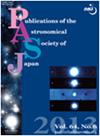ACA CO(J = 2–1) mapping of the nearest spiral galaxy M 33. II. Exploring the evolution of giant molecular clouds
IF 2.2
4区 物理与天体物理
Q2 ASTRONOMY & ASTROPHYSICS
引用次数: 0
Abstract
The evolution of giant molecular clouds (GMCs), the main sites of high-mass star formation, is an essential process to unravel the galaxy evolution. Using a GMC catalogue of M 33 from the ALMA-ACA (Atacama Large Millimeter/submillimeter Array–Atacama Compact Array) survey, we classified 848 GMCs into three types based on the association with H ii regions and their H$\alpha$ luminosities $L\, (\rm{H}\alpha )$: Type I is associated with no H ii regions; Type II with H ii regions of $L\, (\rm{H}\alpha )$ $\lt 10^{37.5}$ erg s$^{-1}$; and Type III with H ii regions of $L\, (\rm{H}\alpha )$ $\geqq$ $10^{37.5}$ erg s$^{-1}$. These criteria yield 224 Type I GMCs, 473 Type II GMCs, and 151 Type III GMCs. GMCs show changes in their physical properties according to the types; mass, radius, velocity dispersion, and $^{13}$CO detection rate of GMCs systematically increase from Type I to Type III, and additionally, Type III GMCs are closest to virial equilibrium. Type III GMCs show the highest spatial correlation with clusters younger than $10\:$Myr, Type II GMCs moderate correlation, and Type I GMCs are almost uncorrelated. We interpret that these types indicate an evolutionary sequence from Type I to Type II, and then to Type III with timescales of 4 Myr, 13 Myr, and 5 Myr, respectively, indicating a GMC lifetime of 22 Myr by assuming that a Type II GMC has the same timescale as the Large Magellanic Cloud. The evolved GMCs are concentrated on the spiral arms, while the younger GMCs are apart from the arm, both to the leading and trailing sides. This indicates that GMCs collide with each other via the spiral potential, leading to the compression of GMCs and the triggering of high-mass star formation, which may support the dynamic spiral model. Overall, we suggest that the GMC evolution concept helps illuminate the galaxy evolution, including the spiral arm formation.最近的旋涡星系 M 33 的 ACA CO(J = 2-1) 图谱。II.探索巨型分子云的演化
巨分子云(GMCs)是高质恒星形成的主要场所,其演化是揭示星系演化的一个重要过程。利用ALMA-ACA(阿塔卡马大型毫米波/亚毫米波阵列-阿塔卡马紧凑阵列)巡天得到的M 33的巨分子云目录,我们根据848个巨分子云与H ii区的关联以及它们的H$\alpha$光度$L\, (\rm{H}\alpha)$把它们分成了三种类型:I 型不与任何 H ii 区域相关;II 型与 H ii 区域的亮度为 $L\, (\rm{H}\alpha )$$lt 10^{37.5}$ erg s$^{-1}$;III 型与 H ii 区域的亮度为 $L\, (\rm{H}\alpha )$$\geqq$ $10^{37.5}$ erg s$^{-1}$。根据这些标准,得出了 224 个 I 型 GMCs、473 个 II 型 GMCs 和 151 个 III 型 GMCs。不同类型的 GMC 在物理性质上有不同的变化;从 I 型到 III 型,GMC 的质量、半径、速度弥散和 $^{13}$CO 检测率都在系统地增加,此外,III 型 GMC 最接近病毒平衡。III型GMC与小于$10:$Myr的星团的空间相关性最高,II型GMC的相关性适中,而I型GMC几乎没有相关性。我们认为这些类型表明了一个从Ⅰ型到Ⅱ型,再到Ⅲ型的演化序列,其时间尺度分别为4 Myr、13 Myr和5 Myr,假设Ⅱ型GMC的时间尺度与大麦哲伦云相同,则表明GMC的寿命为22 Myr。演化后的 GMC 都集中在旋臂上,而年轻的 GMC 则远离旋臂,无论是在旋臂的前侧还是后侧。这表明GMC通过螺旋势能相互碰撞,导致GMC压缩,并引发高质恒星形成,这可能支持动态螺旋模型。总之,我们认为GMC演化概念有助于阐明星系的演化,包括旋臂的形成。
本文章由计算机程序翻译,如有差异,请以英文原文为准。
求助全文
约1分钟内获得全文
求助全文
来源期刊

Publications of the Astronomical Society of Japan
地学天文-天文与天体物理
CiteScore
4.10
自引率
13.00%
发文量
98
审稿时长
4-8 weeks
期刊介绍:
Publications of the Astronomical Society of Japan (PASJ) publishes the results of original research in all aspects of astronomy, astrophysics, and fields closely related to them.
 求助内容:
求助内容: 应助结果提醒方式:
应助结果提醒方式:


